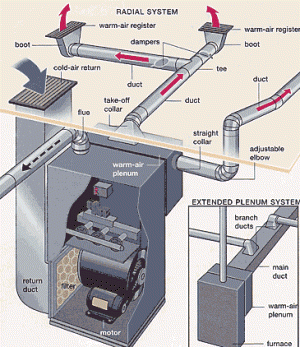Your new heating and cooling system should be a custom fit for your home. Sizing and a handful of other installation practices can dramatically affect how well your new equipment will deliver comfort and savings. Expect to pay a little more for a good contractor who follows these practices.
Calculate the size of equipment
Seal and insulate ducts in attics and crawlspaces

Figure 1 - HVAC furnace and duct system
Calculate the size of equipment:
For starters, your new furnace, boiler, heat pump or air conditioner should be sized to fit your home. This is especially important when installing a boiler, as boiler systems are more complicated and require precise engineering to operate efficiently. A boiler that isn't sized correctly can cost you more in the long run with higher energy bills! With the right installation service, you can enjoy peace of mind knowing your boiler will operate efficiently for years to come. You can request a copy of the design load calculation used to determine the right size of equipment for your home. A good contractor will not size your equipment solely on the square footage of your house or assume that your existing equipment was sized properly in the first place. Proper equipment sizing is based your home's heat loss during cold weather and heat gains during warm weather.
To complete the design load calculation the contractor will need to take measurements during the initial visit to your home and ask you some questions. The calculation is usually done using software, and should be based on professional guidelines such as Manual J from the Air Conditioning Contractors of America (ACCA) or similar method. Oversized equipment can cause reduced comfort and excessive air
noise. Oversizing will shorten the life of the equipment by causing it to cycle on and off more frequently than a properly-sized unit. Undersized equipment, with airflow that is too low, can reduce the efficiency of the air distribution and accelerate wear on system components, leading to premature failure.
After the design load calculation is completed, ducts, supply registers, and return grilles can be sized and selected using professional guidelines in ACCA's Manual D or similar method.
Seal and insulate ducts in attics and crawlspaces:
If you're installing a central air conditioner, furnace or heat pump ask your contractor about the condition of your air ducts. A good contractor should be able to test your air ducts to identify and seal leaks.
Duct sealing should be done by a professional using mastic, metal-backed tape or aerosol-based sealing. In some instances, your contractor may advise you that it is necessary to replace or add ducts. If there are insufficient supply registers or return air grilles in your home, it may be necessary to install additional ducts to accommodate the need for registers or grilles. When possible ducts should be located within conditioned space. If the ducts must be in unconditioned space (attic or crawlspace) they should be insulated.
For central air conditioners, furnaces or heat pumps there is an optimal air flow for comfort and savings. If airflow is too high, duct leakage increases and the temperature at the register is not sufficient for optimal home comfort.
If airflow is too low, distribution efficiency drops and accelerates the wear on system components leading to premature failure.
A good contractor will test the air flow of your heating and cooling system and make adjustments for optimal performance. Typically, testing and adjustments should be done after duct leakage repairs have been completed.
If your are installing a new central air conditioner or heat pump you should know that recent field studies suggest that approximately 75% of installed cooling equipment may have the incorrect amount of refrigerant. Incorrect refrigerant level can lower efficiency by 5 to 20% and can ultimately cause premature component failure, resulting in costly repairs that could have been prevented. A good contractor will use one of three methods, recommended by equipment manufacturers, to verify the correct refrigerant level. These methods include super-heat, sub-cooling, or weigh. Ask your contractor how they verify the refrigerant level is correct.
In addition, you should know that since 1992, in order to protect the earth's atmosphere (ozone layer), all technicians must be certified to handle refrigerant. Ask them to show you proof of refrigerant handling certification.
Placement of new equipment is unique for every home, but a good contractor should follow manufacturer's installation instructions for best results. For example, Indoor equipment should be installed in conditioned space, or a space that is well insulated. The Outdoor compressors should be placed out of the sun and kept free of debris. Equipment should be installed in an accessible area for easy maintenance. Allow plenty of room for free airflow on all sides of the equipment. Thermostats should be placed away from direct sunlight, drafts, doorways, skylights and windows.
